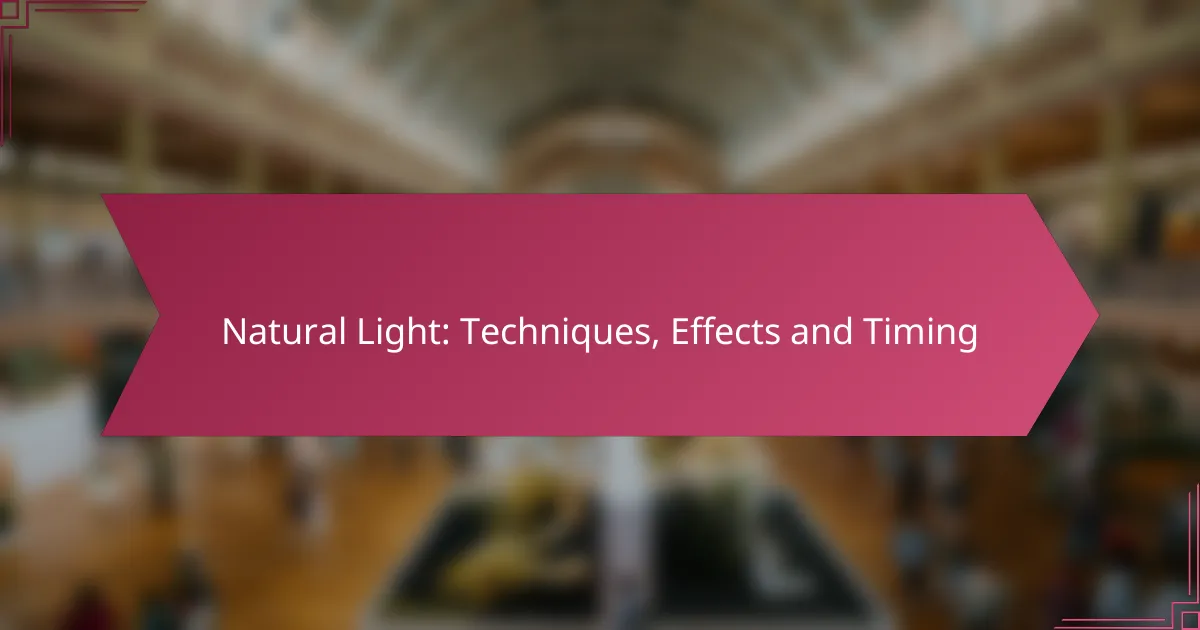Natural light plays a crucial role in photography, impacting the mood, color, and clarity of images. By employing specific techniques to manipulate and optimize this light, photographers can significantly enhance their work. Timing is also essential; capturing images during the golden hours—shortly after sunrise and before sunset—provides soft, warm light that elevates the overall quality of photographs.
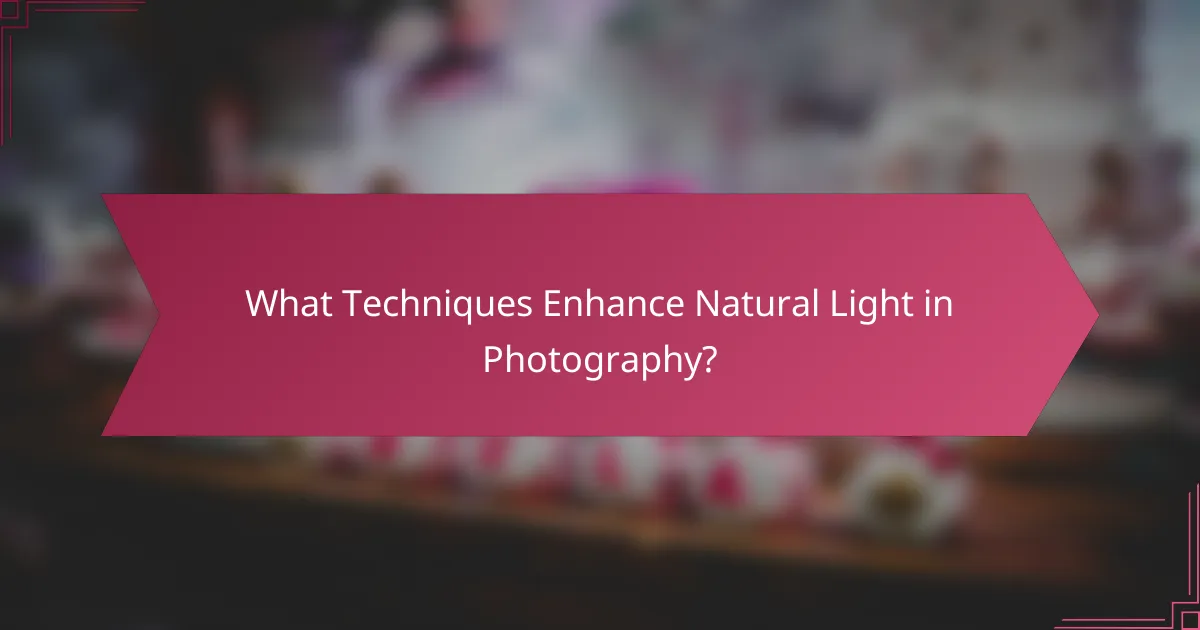
What Techniques Enhance Natural Light in Photography?
To enhance natural light in photography, various techniques can be employed to manipulate and optimize the available light. Understanding how to use these methods effectively can significantly improve the quality of your images.
Golden hour usage
The golden hour, occurring shortly after sunrise and before sunset, provides soft, warm light that enhances the mood of photographs. This period typically lasts about an hour, making it ideal for capturing landscapes and portraits with a flattering glow.
To make the most of the golden hour, plan your shoots around these times. Use a compass or a weather app to determine sunrise and sunset times in your area, ensuring you arrive early to set up your shots.
Reflectors and diffusers
Reflectors and diffusers are essential tools for managing natural light. Reflectors bounce light onto your subject, filling in shadows and creating a more balanced exposure. Diffusers soften harsh sunlight, reducing glare and creating a more even light distribution.
Common materials for reflectors include white foam boards or metallic surfaces, while diffusers can be made from sheer fabrics or specialized photography equipment. Experiment with different angles and distances to achieve the desired effect.
Window light manipulation
Manipulating window light can create stunning indoor photography. Position your subject near a window to take advantage of the natural light streaming in, which can produce soft, flattering shadows.
To control the intensity of the light, consider using sheer curtains to diffuse it or reflectors to bounce additional light onto your subject. Be mindful of the time of day, as the quality of window light changes throughout the day.
Backlighting strategies
Backlighting involves positioning your subject in front of a light source, such as the sun, to create a dramatic effect. This technique can highlight textures and create a beautiful halo effect around your subject.
To avoid underexposed subjects, consider using a fill flash or increasing the exposure compensation on your camera. Experiment with different angles to find the most flattering backlighting for your composition.
Using natural landscapes
Incorporating natural landscapes into your photography can enhance the use of natural light. Elements like trees, mountains, and water can reflect and diffuse light, adding depth and interest to your images.
When shooting in natural settings, pay attention to the time of day and weather conditions, as these factors can dramatically alter the quality of light. Utilize the landscape to frame your subject and create a more dynamic composition.
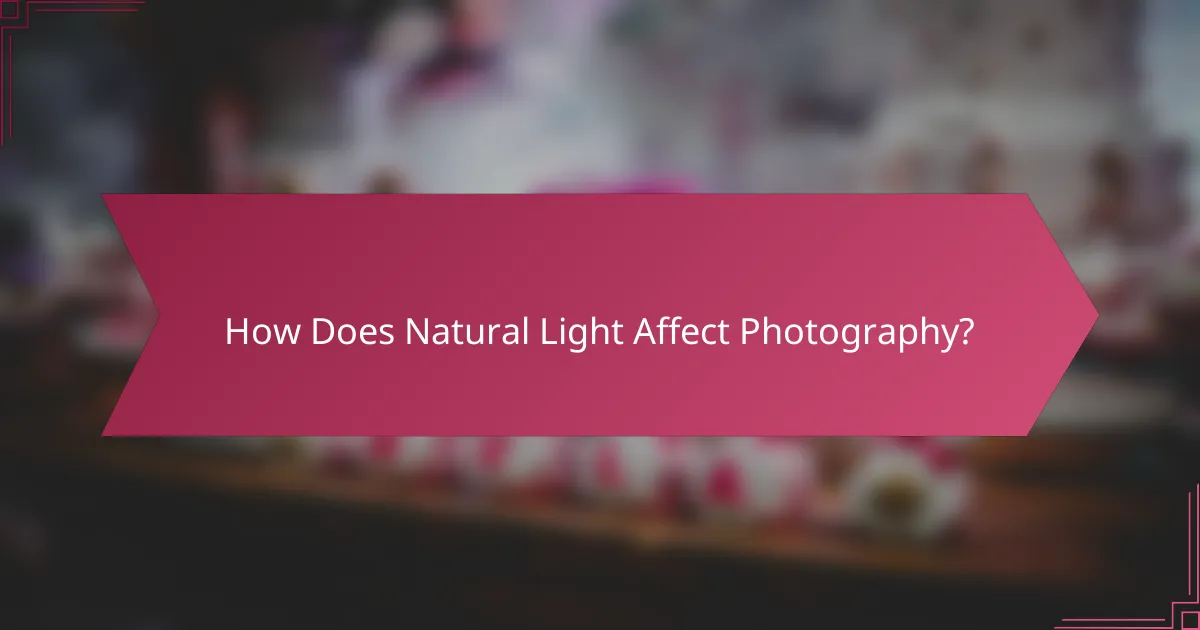
How Does Natural Light Affect Photography?
Natural light significantly influences photography by altering the mood, color, and clarity of images. Understanding its effects can enhance composition and storytelling in photographs.
Color temperature variations
Natural light varies in color temperature throughout the day, affecting the overall tone of photographs. Early morning and late afternoon light tends to be warmer, with a golden hue, while midday light is cooler and harsher. Photographers can use these variations to create different atmospheres in their images.
To effectively utilize color temperature, consider using a white balance setting that complements the lighting conditions. For instance, during golden hour, a warmer white balance can enhance the richness of colors.
Shadows and highlights impact
The interplay of shadows and highlights in natural light can add depth and dimension to photographs. Soft, diffused light during overcast days reduces harsh shadows, making it ideal for portraits. Conversely, direct sunlight creates strong contrasts that can be dramatic but may require careful management to avoid overexposed highlights.
When shooting in bright conditions, consider using reflectors or diffusers to control shadows and highlights. This can help maintain detail in both bright and dark areas of the image.
Subject mood enhancement
Natural light can evoke different emotions and moods depending on its quality and direction. Soft, diffused light often conveys tranquility, while harsh, direct light can create tension or drama. Understanding how to manipulate light can help photographers convey the desired mood in their work.
For instance, shooting during the golden hour can impart a romantic feel, while shooting in the middle of the day might lend a more energetic vibe. Adjusting the angle of the light can also influence the emotional impact of the photograph.
Texture and detail visibility
The visibility of texture and detail in photographs is greatly affected by the direction and quality of natural light. Side lighting can accentuate textures, making surfaces appear more three-dimensional, while flat lighting may obscure details. Photographers should consider the light’s angle to highlight important features in their subjects.
To enhance texture visibility, experiment with different times of day and angles. For example, shooting in the early morning or late afternoon can reveal intricate details in landscapes and architectural subjects.
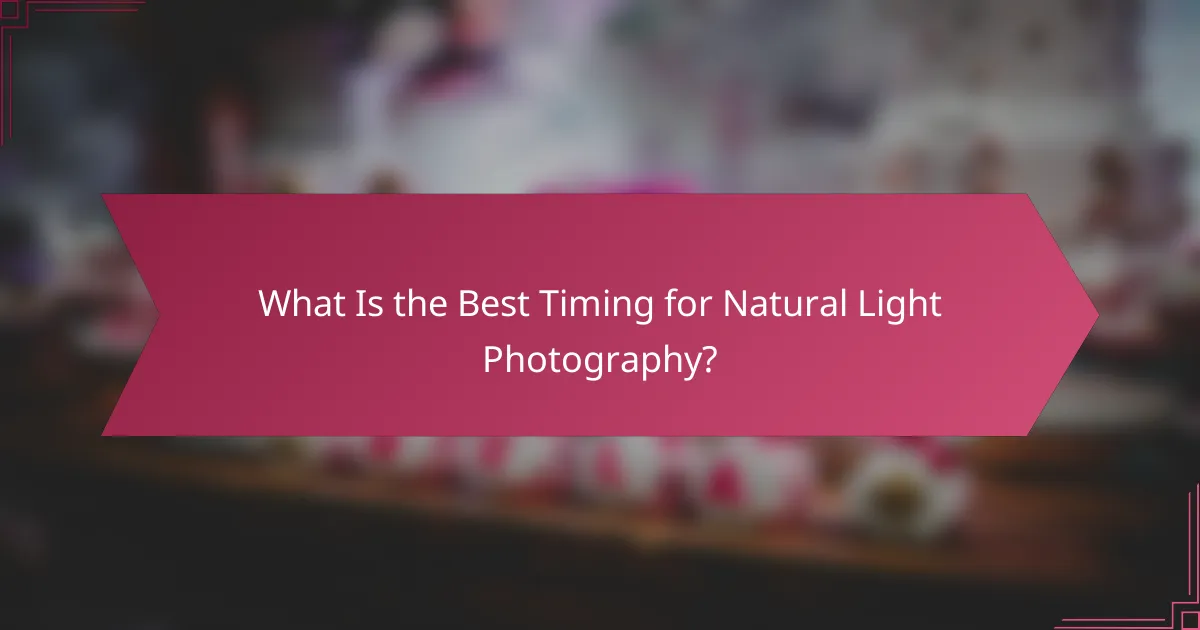
What Is the Best Timing for Natural Light Photography?
The best timing for natural light photography is during the golden hours, which are shortly after sunrise and before sunset. These times provide soft, warm light that enhances the quality of images, reducing harsh shadows and creating a pleasing atmosphere.
Morning light advantages
Morning light is characterized by its soft, diffused quality, which is ideal for capturing landscapes and portraits. The air is often clearer, and the colors are more vibrant, making it easier to achieve stunning images.
Additionally, morning light tends to create long shadows that add depth to photographs. Photographers can take advantage of this by positioning subjects strategically to enhance the overall composition.
Midday light challenges
Midday light can be harsh and unflattering, resulting in strong shadows and overexposed highlights. This is particularly problematic for portrait photography, where even skin tones can appear washed out.
To mitigate these challenges, photographers can seek shaded areas or use reflectors to soften the light. Alternatively, shooting in open shade can help maintain detail in both highlights and shadows.
Evening light benefits
Evening light, similar to morning light, offers a warm and inviting quality that enhances photographs. The sun’s position creates dramatic lighting effects, perfect for capturing silhouettes and vibrant colors during sunset.
This time also allows for creative experimentation with backlighting, which can produce stunning effects, especially with subjects like flowers or people. Planning shoots around this time can yield striking results.
Seasonal variations
Seasonal changes significantly affect the quality and angle of natural light. In summer, the sun rises earlier and sets later, providing extended golden hours, while winter days are shorter, leading to quicker transitions between light and dark.
Photographers should consider these variations when planning shoots. For instance, autumn can offer unique lighting due to the lower sun angle and colorful foliage, creating a distinct atmosphere that enhances images.
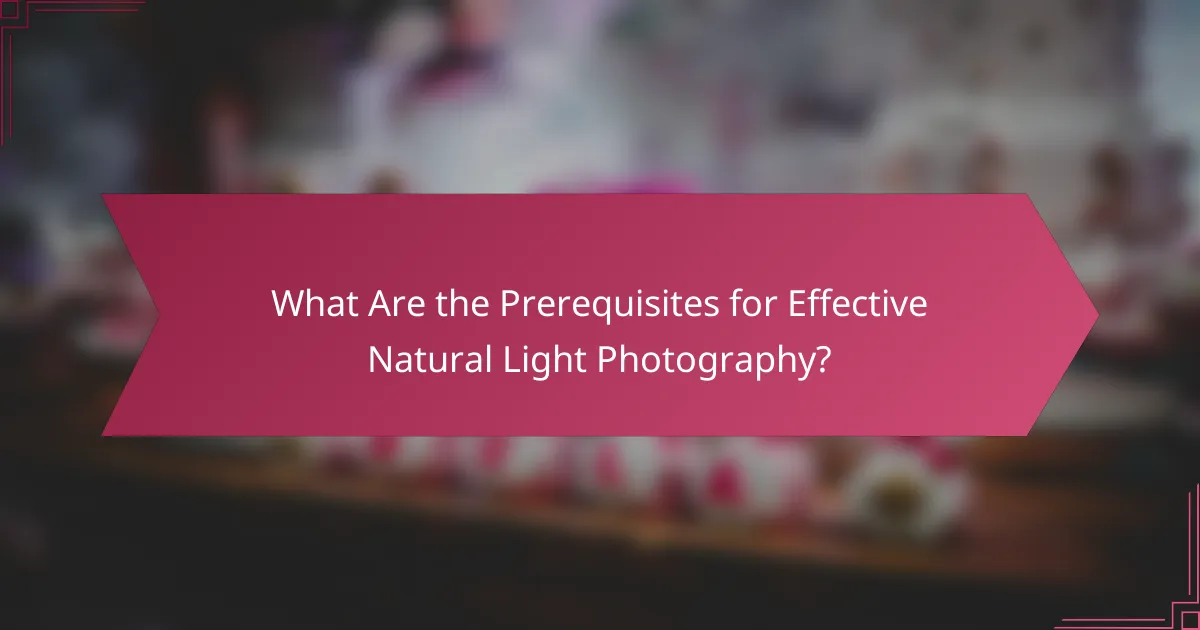
What Are the Prerequisites for Effective Natural Light Photography?
Effective natural light photography requires an understanding of exposure settings, the right equipment, and strategic location scouting. Mastering these elements enables photographers to capture stunning images that utilize available light to its fullest potential.
Understanding exposure settings
Exposure settings are crucial for achieving well-lit photographs. Key settings include aperture, shutter speed, and ISO. A wider aperture (lower f-stop number) allows more light, while a slower shutter speed can capture movement in low light, but may require stabilization techniques.
For outdoor photography, consider the time of day. Early morning and late afternoon provide softer, warmer light, ideal for portraits and landscapes. Adjust your ISO based on the light conditions; lower ISO values (100-400) are best in bright light, while higher values (800-1600) can be used in dimmer settings.
Equipment recommendations
While any camera can capture natural light, DSLRs or mirrorless cameras with interchangeable lenses offer the most flexibility. A fast lens with a wide aperture (like f/1.8 or f/2.8) is beneficial for low-light situations. Additionally, a sturdy tripod can help stabilize your camera during longer exposures.
Consider using reflectors to bounce light onto your subject, enhancing illumination without additional equipment. Portable reflectors are lightweight and can be easily transported, making them ideal for outdoor shoots.
Location scouting tips
Choosing the right location is essential for effective natural light photography. Look for areas with interesting backgrounds and varying light conditions, such as open fields, urban settings, or shaded forests. Each location can yield different moods and effects based on the time of day.
Visit potential locations at different times to observe how light changes. Take note of shadows and highlights, as these can dramatically affect your composition. Keep a list of preferred spots and their best shooting times to maximize your opportunities for great shots.

How to Choose the Right Natural Light Techniques?
Selecting the appropriate natural light techniques involves understanding your environment, the desired effect, and the time of day. Key factors include the direction of light, intensity, and how it interacts with your subject. Experimenting with different techniques can help you find the best fit for your specific needs.
Understanding Light Direction
Light direction significantly affects the mood and texture of your images. Front lighting creates even illumination, reducing shadows, while side lighting adds depth and dimension. Backlighting can create silhouettes or highlight translucency, making it essential to consider the subject and the desired effect.
Manipulating Light Intensity
The intensity of natural light varies throughout the day and can be influenced by weather conditions. Early morning and late afternoon often provide softer, warmer light, ideal for portraits. In contrast, midday sun can produce harsh shadows and bright highlights, which may require diffusion techniques or reflectors to soften the light.
Timing Your Shots
Timing is crucial when working with natural light. The golden hour, shortly after sunrise and before sunset, offers the most flattering light for photography. Conversely, the blue hour, just before sunrise or after sunset, provides a cooler tone that can enhance mood and atmosphere. Planning your shoots around these times can significantly improve your results.
